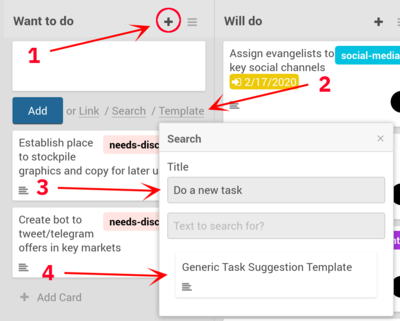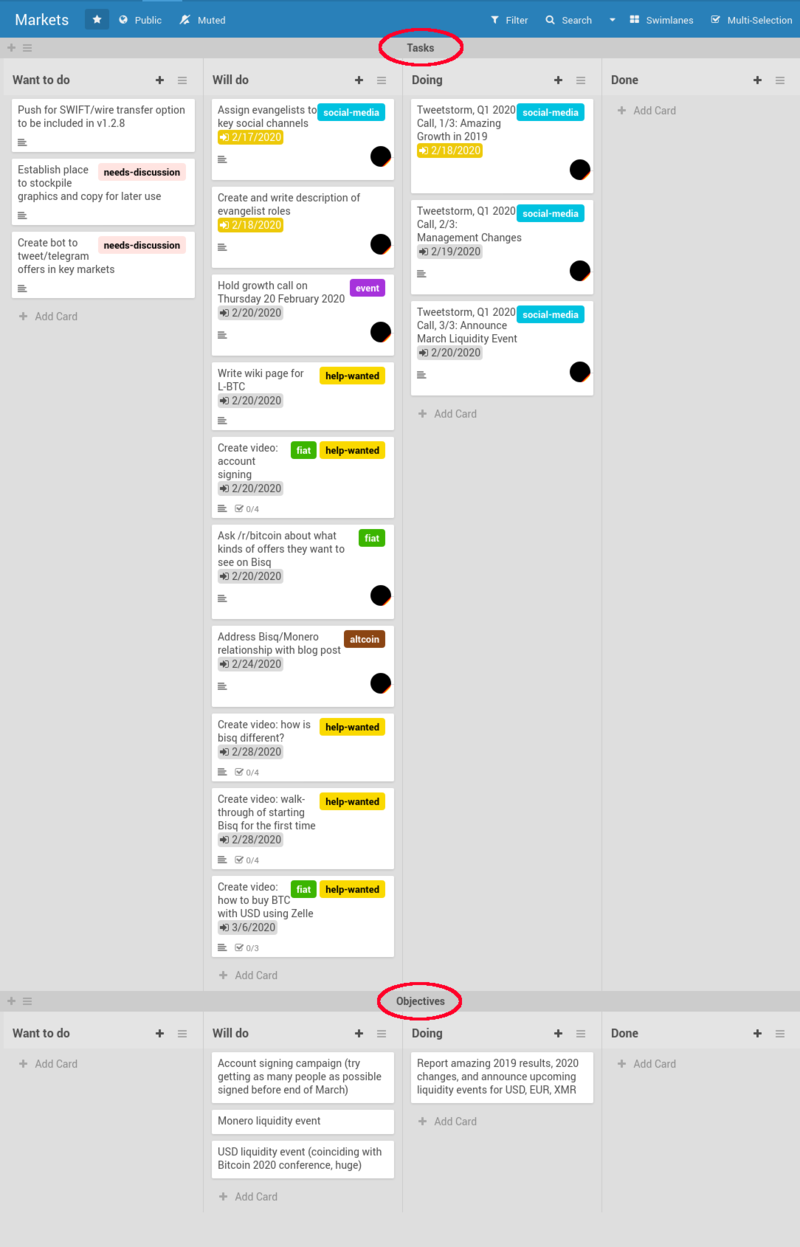Difference between revisions of "Growth Team"
Plebeian9000 (talk | contribs) (add first iteration of growth workflow for cycle 11) |
Plebeian9000 (talk | contribs) (add note suggesting contributors to add their own growth objectives) |
||
| Line 51: | Line 51: | ||
Here's an overview of objectives for the next ~1.5 cycles. In the future, we'll plan further out. | Here's an overview of objectives for the next ~1.5 cycles. In the future, we'll plan further out. | ||
| − | You'll see these objectives listed in the ''Objectives'' "swim lane" of the markets board (see section below). | + | You'll see these objectives listed in the ''Objectives'' "swim lane" of the markets board (see section below), where you can suggest your own growth objectives. |
{| class="wikitable" | {| class="wikitable" | ||
Revision as of 17:35, 17 February 2020
This page covers the workflow for Bisq's growth function. If you're interested in helping Bisq grow, please read through this page carefully.
It will be updated before the start of every Bisq DAO cycle.
Contents
Introduction
Bisq growth efforts are focused squarely on growing trading volume in key markets.
To that end, all growth efforts should directly influence trading in key markets.
Key markets are USD, EUR, and XMR. For the moment, we'll also devote some resources to L-BTC and CNY markets because of their considerable importance and potential.
Responsibilities of the growth function:
- manage market-making bounties
- carry out marketing and publicity efforts
- maintain the Bisq website
- manage translations across the website and software
The rest of this page covers the workflow for coordinating these responsibilities.
Budget
The focus on growing volume is apparent in the budget for Cycle 11:
| Item | Allotment (USD) |
|---|---|
| Fiat | 2800 |
| Altcoin | 2000 |
| Evangelists | 1800 |
| Website | 1000 |
| Translations | 500 |
| Analytics | 100 |
| Total | 8200 |
While the website and translations are important, big improvements are not critical, so their budgets just allow for routine maintenance.
Altcoin volume growth is especially important for Bisq to achieve its goals, but altcoin trading on Bisq is vastly simpler than fiat trading, so the lower budget should be sufficient.
Upcoming Objectives
Here's an overview of objectives for the next ~1.5 cycles. In the future, we'll plan further out.
You'll see these objectives listed in the Objectives "swim lane" of the markets board (see section below), where you can suggest your own growth objectives.
| Week of 17 February | Report amazing 2019 results, 2020 changes, and announce upcoming liquidity events for USD, EUR, XMR |
| Week of 24 February | Account signing campaign (try getting as many people as possible signed before end of March) |
| Early March | Monero liquidity event |
| Late March | USD liquidity event (coinciding with Bitcoin 2020 conference, huge) |
Coordinating Efforts
With these high-level goals and upcoming objectives in mind, I've created a couple of kanban boards to better plan, visualize, and coordinate our efforts. These boards will be the "system of record" for all Bisq growth efforts: if a task is not on one of these boards, there's a strong chance it's not a priority and may not be compensated. In other words, please make sure anything you expect to be paid for is marked as Doing and assigned to you before starting it.
Here's an overview of the boards, as they stand at the beginning of Cycle 11.
| Board Name | Link | Description |
|---|---|---|
| Markets | https://grow.bisq.cc/b/jPBBopYuLdGYdDpvF/markets | Covers market-making, content creation, discrete social media tasks, and other markets-related to-do items. |
| Bitcoin 2020 | https://grow.bisq.cc/b/Ro4TSwKHuYoTwixsz/bitcoin-2020 | Covers all preparations for the Bitcoin 2020 conference in San Francisco on March 27-28. |
| Translations | https://grow.bisq.cc/b/pS7ZjPr2A5oEAvD5D/translations | Covers all translations work for the website and software. |
All the boards are public, so you can view them by clicking on the links above without without creating an account.
Workflow
If you'd like to take on a task on a board, or if you'd like to suggest a task that isn't currently on a board, you will need to create an account.
Here's how this works.
1. Familiarize yourself with the function's upcoming objectives and budget allotments (see above).
2. Take a look at the board corresponding to the work you'd like to do.
Note that the website doesn't have its own board—it's a GitHub repository, so its workflow is managed in GitHub issues and pull requests.
All boards are structured similarly—each has 4 categories to indicate task statuses:
- Want to do are tasks that have been suggested but not budgeted, prioritized, or assigned.
- Will do are tasks that have been budgeted and prioritized, but not yet assigned (
help-wantedtag) or not yet begun. - Doing are tasks that are budgeted, prioritized, assigned, and in progress.
- Done are tasks that are done.
Some boards, like the Markets board and Translations board, have an Objectives swim lane to correspond tasks with higher-level objectives. We'll cover this below.
3. Take on a task
Tasks ready to take on are labeled help-wanted in the Will do list. If you'd like to take on one of these tasks, please:
- Add a comment on the card with any details or questions you'd like to cover before starting work. Most importantly, please add your expected compensation amount for completing the task. If an amount is already specified, please indicate your acceptance of that amount (or suggest another amount if you wish).
- Add the
assignment-requestedtag. This helps reviewers actually see that the status of the task has changed. - A reviewer will get back to you within ~1 day, cover any outstanding concerns, and move the task to Doing if all goes well. You can begin working.
If you don't see the task you want to do already listed in Will do, you'll need to create a new task in Want to do. It's crucial you create the new task in this column, because this is how we discern prioritized tasks from not-yet-prioritized work.
- Click the plus sign to add a new task in the Want to do column, click
Template, type a title for your suggestion, and then click Generic Task Suggestion Template'. This will generate a new card with a pre-filled form in the card's description. - Fill out the form in the card's description.
- Within ~1 day, a reviewer will address your suggestion by either moving it to Will do (indicating it's prioritized and ready to begin) or archiving it (meaning it wasn't deemed a priority).
Here's an illustration of step 1 from above:
4. Suggest new objectives
Got an idea for a new objective, like a new campaign or a new higher-level initiative that Bisq should devote resources to?
Please suggest it in the Want to do column of the Objectives swim lane for review and discussion.
You'll see current objectives (as specified here) already listed in the Will do and Doing columns.
Ideally every task in the top swim lane will continue to correspond to an objective in the bottom swim lane.
Ongoing Efforts
There are some growth efforts not reflected on the project boards discussed above. These efforts are handled by contributors who have roles that involve ongoing efforts not practical to track on a discrete task-by-task basis.
These include:
- Following, managing, and reporting on activity happening across key social channels
- Maintaining market making bounties and collaborating with market makers to keep supply side solid
- Determining campaign/initiative calendar
These roles will be documented in the coming days.
Cadence
This workflow should allow growth contributors to work asynchronously, largely independent of a need for frequent meetings and events happening at particular times. Still, we need to establish time frames for some things.
- Thursdays. Evaluate objectives suggested in Want to do and either schedule them or archive them. This can be accomplished by simply posting suggestions in #growth on Keybase and having community members vote with emojis.
- Every other Thursday. Hold a call for the user base, called Bisq PULSE, which is a progression of the Bisq BRIEF series. The call would summarize happening relevant to Bisq, notable items from the #pulse channel, important announcements, growth milestones, and any other initiatives or items worth communicating to users. Presented in Socratic seminar style, preferably by more than 1 person. Would be nice to have this adopt more of a podcast feel.
- Every month, or as needed. Have calls with all consistent growth contributors to take a step back from the day-to-day and share feedback, concerns, and other suggestions. Could also be useful for longer-term strategizing, process/workflow analysis, etc.
Events will be announced on the #growth channel on Keybase and put on the calendar at https://bisq.network/calendar.
Communication
The #growth channel on Keybase is the primary means of communication for growth.
There's also the #transifex channel for translations and the #website channel for the website (along with the bisq-website GitHub repository).
For now, market making bounties will continue to be tracked in the growth repository on GitHub, but this may change.
If you're a consistent contributor, please also make sure you're a member of the Bisq GitHub organization so that you can follow updates in the GitHub discussions area.
Compensation Guidelines
Every so often contributors disagree on what constitutes fair compensation. The growth function is particularly afflicted by this since the value of content creation and speaking/travel is not always immediately obvious.
As detailed above, part of the process of allowing contributions to begin involves agreeing on a ballpark compensation figure for completing the work as specified. From now on, no work should be done without mutual agreement on compensation.
For the moment, please make sure you follow the process outlined above for any such contributions and we'll do our best to work together until more specific guidelines are in place.
Feedback
This new process is a work in progress, and will be refined over time.
If something doesn't make sense, seems inefficient or unnecessary, or just annoying or confusing, please speak up on #growth.

